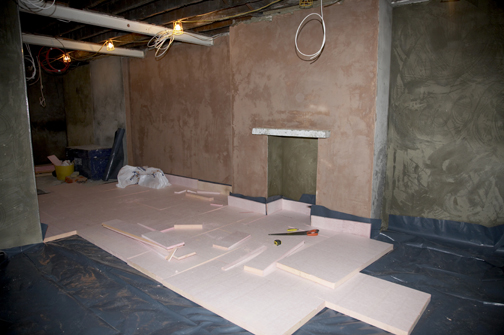In this new series, Chartered Surveyor Ian Rock FRICS – Author of the Haynes Home insulation Manual – explains how to cut your energy bills by boosting your home’s thermal efficiency.
PART ELEVEN:
How To Insulate Solid Floors
Cold feet? This is how you can make solid concrete floors warmer
Most homes built since the 1950s have ground floors made from thick slabs of solid concrete. Go back a little further in time and houses built with traditional suspended timber floors will often also have tiled solid floors to their kitchens or entrance halls.
Because floors are part of the building’s ‘thermal envelope’ room warmth will be lost through them. And for much of the year the surface can feel cold to walk on, unless it’s been thickly carpeted.
Even recently constructed homes with modern suspended concrete ‘beam & block’ ground floors can often benefit from improved insulation (particularly where the insulation was skimped or omitted on site).
Thermal performance
Solid ground floors score low in terms of comfort levels, particularly during the long winter months. In a typical home the amount of the heat lost through the floors is around 15% of the building’s total heat loss and because solid floors are in direct contact with the ground, ‘thermal bridging’ allows warmth to be conducted out of them. This is often made worse by cold draughts whistling across the surface.
Despite such concerns, the amount of heat lost through floors is generally quite a bit less than the amount lost through walls or roofs.
The reason for this is that the ground underneath isn’t as cold as the outdoor air circulating around the rest of the property’s thermal envelope. This is because the ground retains a certain amount of warmth, the temperature remaining reasonably stable all year round (evident if you dig down a few feet in cold weather).
Ground Source Heat Pumps work on this principle, taking advantage of the ‘stored warmth’ beneath our feet. Nonetheless, the total amount of heat that is lost through floors is still significant – more than escapes through single glazed windows for example – and few homeowners doubt the thermal benefits of installing double glazing.
Although upper floors are normally made of timber and don’t need insulating (not being part of the building’s thermal envelope) there are some types of property where concrete floors are found at higher levels, such as in some blocks of flats. Balconies are sometimes made from concrete floor slabs sticking out of the wall and can act as a ‘heat sink’ transmitting warmth from indoors to the cold outdoors (and vice versa).
Planning the job
Carrying out insulation work to floors is obviously going to cause a fair amount of disruption. So there are a number of other points that need to be considered in advance:-
* Disruption
This would be a straightforward job if it wasn’t for the fact that raising floor levels by more that a centimetre or two is likely to require major adjustments elsewhere, particularly if you need to move fitted units in kitchens and cloakrooms etc.
To minimise disruption, the works can be carried out on a room by room basis when the opportunity arises. But given that heat loss through solid floors is not as high as elsewhere in the house, and that laying thick carpets can make a difference with minimal upheaval, this is one part of the house where insulating may not be a priority.
However, where an existing floor is due to be taken up, perhaps as part of a larger refurbishment project, it’s well worth taking advantage of the opportunity to improve its thermal efficiency.
* Under floor heating (UFH)
If you’re looking to upgrade your room heating you may want to consider retro-fitting UFH. The UFH warm water pipes are run on top of purposes-made rigid insulation boards laid on the floor. To keep any necessary raising of floor levels to a minimum, it may be possible to break up the old screed, or fit special microbore UFH pipes. Alternatively electric UFH systems utilise thin ‘heating mats’ that may be suitable for smaller rooms under tiled surfaces, such as cloakrooms.
* Period properties
In old houses, floors can be a significant part of the history and character, so it’s important not to damage old tiles and flagstones etc.
In historic properties, solid ground floors allowed any moisture to harmlessly evaporate away through the surface or via joints to tiles or flagstones. So laying impermeable artificial coverings, such as vinyl flooring or rubber–backed carpets will block evaporation. Instead they can be protected by a sheet of breather membrane and a suitable breathable insulation board, such as wood-fibre, laid on top with an appropriate finish of tiling or floorboards.
Choosing materials
The Building Regulations set a U-value target of 0.25 W/m2K for upgrading existing floors.
Floor insulation obviously needs to be pretty tough with a high compressive strength. Ready-made insulated floorboards are also available with the insulation pre-bonded to a timber deck.
A typical choice of products might include:-
* Rigid plastic foam boards ( e.g. PIR / PUR / or PF)
* Rigid polystyrene (EPS or XPS)
* Foamed glass
* Rigid natural materials e.g. wood-fibre and hemp-lime boards
* High tech – vacuum panels
Fitting the insulation
Solid floors can be insulated very simply by laying insulation boards above the existing surface to form a new ‘floating’ floor. It’s common practice to lay a sheet of damp-proof membrane beneath the insulation except in older properties where maintaining breathability is desirable.
A suitable surface can then be laid over the top with the desired finish, such as timber floorboards, laminate flooring or tiles.
So far, this is plain sailing. The difficult bit is making all the necessary adjustments to joinery and fittings to accommodate the higher floor level. To get all the detailing right requires careful planning. Skirting boards and door thresholds will need to be re-fixed.
Also the bottom of each door and the architraves to the frame will need to be cut to allow for the increased thickness of the new floor, and you may even need to raise the top of the frame and reposition the lintel to maintain sufficient headroom. In rooms with very low ceilings (such as some basements) the effective reduction in headroom can also be an issue.
But the biggest challenge is normally at the bottom of the stairs, because to comply with Building Regulations (and for safety) the lowest step mustn’t be shorter than the other steps.
One solution can be to build up the floor at the base of the stairs so it’s level with the bottom step, effectively incorporating it in a bigger new platform. This will form a new ’landing’, at least a metre long x the width of the stairs. A shallower step can then be formed between this landing and the surrounding newly insulated floor.
NEXT MONTH: Windows – why double glazing isn’t all it’s cracked up to be
Ian Rock’s home insulation tips are taken from the new Haynes Home Insulation Manual. For further information see www.home-insulating.com







